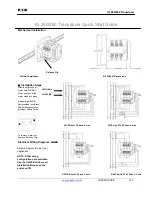
20
2-2, VOX TEST AND TROUBLESHOOTING
Relay K1 provides the internal switching for the transmitter. Tube V13B is the control element for K1. V13
B
gets its turn on command from the PTT line
or
the VOX subsystem. When in the VOX mode a sample of the
first mic amp (V2) output is fed to the VOX circuit (V12A and V13A). The VOX circuit sniffs this signal
rectifies it to create a DC voltage relative to the mic input signal. A voltage divider in the cathode of V14C
which is connected to the grid of V13B sets up the quiescent off state for V123B. The DELAY control R90 sets
this quiescent state and the delay in cutoff when mic audio is no longer present. This quiescent state can be
triggered by rise in voltage on the grid of V13B or a lowering of the voltage on the cathode.
•
In the VOX mode the mic signal amplified by V12A and V13A and rectified by V14C drives the grid of
V13B into the on state thus energizing K1.
•
The vox drop out delay is controlled by time constant of C112, R90, R89, R88 and the function and
operation switches.
•
When the OPERATON switch is in the MOX position S4A REAR pin 7 grounds any signal from the
vox amp preventing the vox from controlling relay K1.
•
In the CW function all the timing resistors are in the circuit providing the longest drop out time.
•
When the FUNCTION switch is in AM, USB or LSB switch S3A REAR pin 9 places a gnd at the
junction of R88 and R89 thus reducing the DELAY time constant for the voice modes.
•
When the operation switch is in the MOX POSITION the PTT line is routed to the cathode of V13B.
When the PTT line is grounded the reverse bias on the cathode is removed and V13B turns on.











































